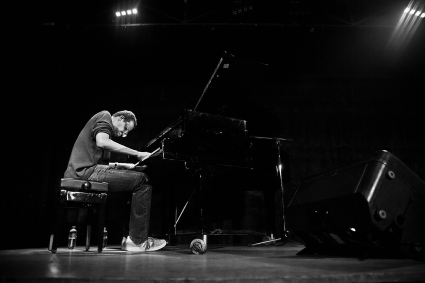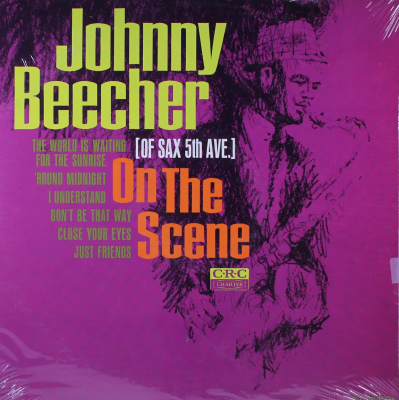.
.
Dmitry Rozhkov, CC BY-SA 4.0 via Wikimedia Commons

Matthew Shipp in Moscow; May, 2017
.
.
___
.
.
Thoughts on Matthew Shipp’s Improvisational Style:
Inspired by Clifford Allen’s Singularity Codex: Matthew Shipp on Rogueart
by Jim Feast
.
…..In February, 2025, I attended a residency Matthew Shipp had at The Stone in New York City. In listening to the music at this venue, I was struck by the deep rapport between the musicians in the various configurations, which changed every night. Although I don’t know the background to these specific concerts, I learned from reading interviews with Shipp that in many of his ensemble sessions the players jump off with no agenda, no pre-planning – the freest of free jazz. So, I wondered, short of all the musicians being mind readers, what accounts for their incredible mutual attunement as they play?
…..Reading Clifford Allen’s wonderful recently published book Singularity Codex: Matthew Shipp on Rogueart, I was clued in on two traits that help explain the way his ensembles work together, allowing for this unity. The first, which might seem a bit unusual, is the time devoted to conversation. The second is a special kind of involvement on the bandstand, which might be called versatile listening.
.
Conversation
.
….. Idealizing, one can imagine a traditional jazz band approaching a recording date. The leader hands out the charts in advance and confers with the members about what tunes will be played, the order of the solos, the tempi and connected matters. Although the leader could, it would not be necessary for an individual musician within the ensemble to know much about the other players aside from their musical strengths. In contrast, when Shipp and fellow musicians are informally planning a recording session – which will involve spontaneous improvisation – they do so with a prior grounding in conversation.
…..Bassist Joe Morris says this about how Shipp organizes a session: “Basically, he is coordinating the configuration of everything in dialogue with people socially, and then in a musical dialogue. A lot of the planning and configuration is him trying to understand how it will work, proposing and examining things, making a decision about it with people” (my itals). Morris later makes this more explicit, “I listen to [other people’s] music sometimes and think they should stop reading the paper and talk to each other. They should talk about what they like and they should talk about what they do and they should talk about how they’re stuck.” He explains that for those he plays with, “you’re able to engage in [high-level] improvisation … [because] you can adhere to a framework that you’ve developed in conversation with people.” Shipps adds, when discussing his playing with Rob Brown, “Because we’ve been playing a long time together, spoken about music and listened to records together, we can know what we’re going for.”
…..In general, in a Shipp-led session, he and his fellow players have thoroughly familiarized themselves with each other’s full personalities through debate, unfettered talk, listening to music together and kibbitzing. From this basis they create an inter-reliant music.
.
In the Moment
.
…..In a more traditional jazz setting, in preparation for a performance the players will know the tunes and their tempo in advance. If one is playing in a freer jazz setting, without the blocking of a tune – although tempo and other basics may have been agreed upon – an individual player’s awareness of his or her bandmates’ moving-along excursions must be acute, enormously attuned to the crossing wavelengths of the other musicians, demanding what might be called versatile listening.
…..Mark Helias, who had less contact with Shipp before making a recording with him than is generally the case for those Shipp works with, made this interesting comment; “Once we got over the initiation [as they began playing], we assessed subtleties in each other’s approach and that allowed us to create together … We listened and we were rewarded.”
…..To assess the subtleties would seem to demand an all-around awareness of the unfolding moment, something (that according to some interpretations) is described in the I Ching. According to Jung and his school, the I Ching is about predicting, but not in the sense of knowing what will happen later but rather in being fully aware of what tendencies are contained in the present moment. By knowing these currents, an accurate view of what will take place is obtainable. As Jungian commentator Marie-Louise von Franz puts it; “According to it [the I Ching], one can determine the meaning of a given moment.” (my emphasis). One relies on the magical predictive power of the I Ching because all the directional strands of a single moment are well-nigh unfathomable.
…..However, there is more to the story. The philosopher of cognition Brian Massumi, who studies actions taking place below registering consciousness, can contribute here. It’s hardly news that improvising musicians select the notes to play without thinking about it (as people do many tasks). Massumi looks at how cognitive studies have unpacked a below-consciousness level of thoughtful, decision-making “awareness.” He writes, “A second aspect [of this level] is the taking form of a field of potential holding within itself a multiplicity of paths of action, corresponding to different outcomes.” To use an example to explain this abstract language, when a musician is improvising – for example, a pianist playing against a backdrop of drums and bass – in his or her mind, taking the sonic environment into account and operating below consciousness, each instant offers a number of possible options. These options and tendencies “fight it out among themselves,” all taking place simultaneously until “the co-motion of tendencies works itself out, and one issues forth into action.”
…..In one sense what this tells us is that the ability to make split-second, considered choices among many possible actions is not some extraordinary gift possessed by improvisers, though they may have honed it to an exceptional degree, but rather a common human trait. But this also throws further light on the first point. These below-consciousness sorting of possibilities and choice, taking place at lightning speed, are based on a thorough drawing upon of an individual’s background memories. If, for example, today Shipp is playing a duet with bassist Michael Bisio, the fact that along with having played together they have also spent time talking about music, listening to records together and hanging out means that when they interlace their music, they are drawing on their knowledge of each other as human beings. This helps explain what I mean by versatile listening. This occurs when in a musical interaction between players – where their improvisational playing complement one another’s – they are listening to each other knowing the full palette of the humanity of the other musicians. This helps me understand how Shipp and his collaborators can play together like sorcerers with mind-reading skills.
.
.
Listen to the Matthew Ship Trio play “Sea Song” from their 2024 album New Concepts in Piano Trio Jazz, with Shipp (piano); Michael Bisio (bass); and
Newman Taylor Baker (drums). [!K7]
.
.
___
.
.

Jim Feast has been attending the concerts of Matt Shipp for over 20 years, and he recently copy-edited Shipp’s new book, Black Mystery School Pianists and other writings, which is forthcoming. He has published the mysteries Long Day, Counting Tomorrow (Autonomedia) and Karl Marx, Private Eye (PM Press). He holds a Ph.D. in English from New York University.
.
.
Jim makes reference to Clifford Allen’s book Singularity Codex: Matthew Shipp on Rogueart. Information about the book can be accessed by clicking here.
.
.
___
.
.
.
Click for:
Other essays published on Jerry Jazz Musician
Information about Kinds of Cool: An Interactive Collection of Jazz Poetry
More poetry on Jerry Jazz Musician
“Bluesette,” Salvatore Difalco’s winning story in the 67th Jerry Jazz Musician Short Fiction Contest
More short fiction on Jerry Jazz Musician
Information about how to submit your poetry or short fiction
Subscribe to the (free) Jerry Jazz Musician quarterly newsletter
Helping to support the ongoing publication of Jerry Jazz Musician, and to keep it commercial-free (thank you!)
.
___
.
.
Jerry Jazz Musician…human produced since 1999
.
.
.

































